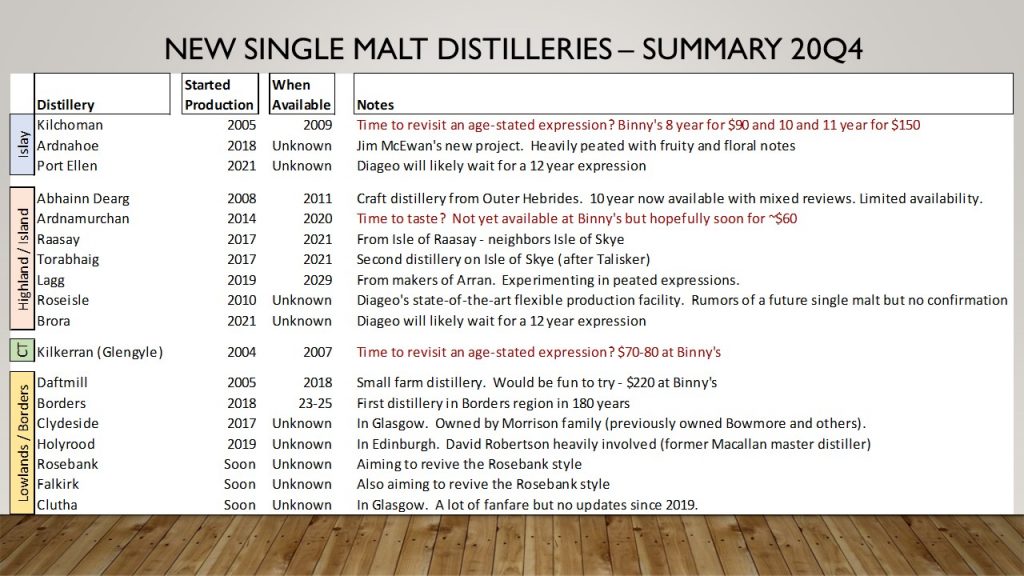I came across a posting by Brother Lakeview following the 06Q4 tasting (sushi paired tasting at Bluff’s) where, after much discussion, a number of future homework assignments, considered to be of interest to the group, were posted. For the most part we haven’t touched these ideas much at all. One of them was “what are Scotland’s three officially oldest distilleries?” I think this question may have sprang from Balblair, a very old distillery, finding its way to a tasting for the first time in 06Q4.
Deciding which distilleries are the oldest largely lies in the definition of “official”. Based on the following factors, which you may or may not agree with, I have formulated a list of the three oldest distilleries. I also annex to this list three other stories of distilleries and their claims to which I will let you decide their merits in overwriting the “official” list. One other item of note, I find in the data that the older distilleries tend to be on the smaller end with respect to capacity. This makes sense to me for a number of reasons (building technologies, scale, demand, etc.) and may be a factor in the demise of old distilleries like Littlemill (isn’t bigger always better?!?).
Factors in establishing “old distilleries”
Rule: Distillery = physical plant; not (brand) name
Implication: Producing spirit in the same building is the single most important consideration even if the enterprise changes names along the way
Rule: Name<>Distillery
Implication: Just because a distillery shares a name with an earlier, separate, and older distillery doesn’t mean that there is a historical connection to that older distillery
Rule: Distillation does NOT require an official license and may be founded before the Excise Act of 1823.
Implication: Illicit and/or established whisky production is considered in the chain if documented and remaining in the same building
Rule: Active NOT Dismantled/Demolished
Implication: To be the oldest “distillery” you have to be currently “distilling” spirit
So, with the above rules in mind, here are…
SCOTLAND’S THREE OLDEST DISTILLERIES
Bowmore, 1779
From the Malt Whisky Yearbook: “Founded in 1779, by John Simpson, Bowmore is Islay’s oldest distillery”
Capacity: 2,000,000 litres/year
Strathisla, 1786
From the Malt Whisky Yearbook: Strathisla is the oldest distillery in the North of Scotland
Capacity: 2,400,000 litres/year
Balblair, 1790
From the Malt Whisky Yearbook: One of Scotland’s oldest distilleries, Balblair was founded in 1790 by John Ross.
Capacity: 1,330,000 litres/year
I give you the following list as alternatives to the above “official” listing. I will leave it to the reader to decide where these place on the “official” list.
For You To Decide
** Undocumented Evidence **
Glenmorangie, “early 18th century”
From the Malt Whisky Yearbook: The Glenmorangie distillery was established in 1843, on the Durnoch Firth by brothers William and John Mathesen. The site originally held a farm distillery under the name Morangie. There is evidence that distillation was carried out at this site during the early 18th century. Officially documented production began in November of 1849.
** Distillery refurbished after dismantling…is it the same? **
Glenturret, 1775
From the Malt Whisky Yearbook: The owners claim the distillery is one of Scotland’s oldest and it is certainly rumoured that distillation was carried out in the area during the early 18th century. Whisky smugglers establish a small illicit farm distillery named Hosh Distillery in 1775. John Drummond is licensee from 1818 until 1837. In 1875, the Hosh Distillery takes over the name Glenturret Distillery and is managed by Thomas Stewart. Between 1921 and 1959 production ceases and the buildings are used for whisky storage and later agricultural storage. 1957 James Fairlie buys the distillery and production restarts in 1959.
** Very old but now demolished **
Littlemill, 1772 (or perhaps the 1300s?)
From the Malt Whisky Yearbook: There are rumours that Littlemill is Scotland’s oldest distillery, possibly even the oldest in the world. Of course, such things are hard to say for certain, though Littlemill has indeed had a long history. The site may have been used for distillation as early as the 1300s. The distillery proper was founded in 1772 by George Buchanan of Glasgow following the acquisition of the Auchterlonie estate.

